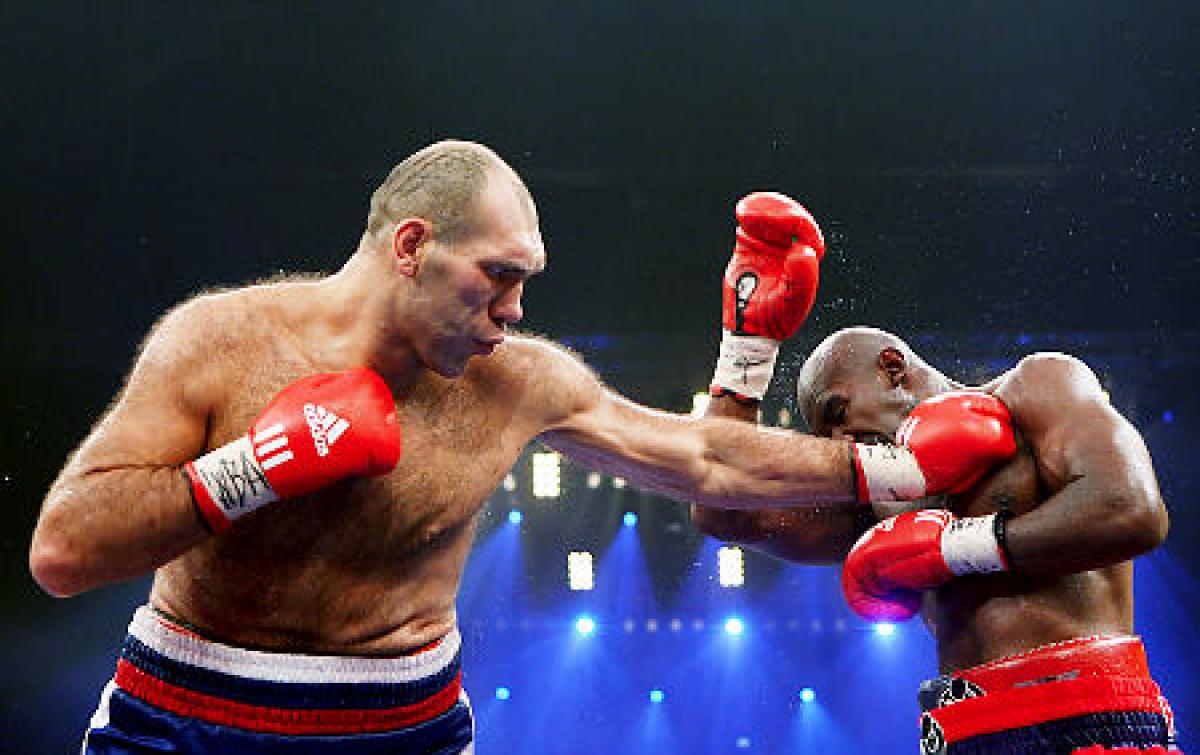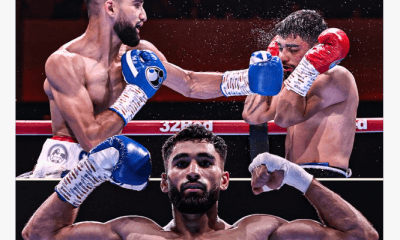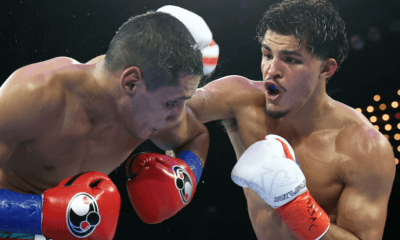Canada and USA
This Day in Boxing (Dec. 20): When the Russian Giant Fleeced the Real Deal

THE VALUEV-HOLYFIELD HEIST — There is a line from one of Elvis Presley’s lesser-known songs, Big Boss Man, that could apply to the deceptively impressive record of two-time former WBA heavyweight champion Nikolai The Russian Giant Valuev.
“Well, you ain’t so big,” Elvis warbled. “You’re just tall, that’s all.”
At 7 feet and weights ranging from 310¾ to 328 pounds during his two title reigns, the hulking Valuev wasn’t just a very large heavyweight; he was the closest thing boxing has ever seen to the Frankenstein monster. Unfortunately for Valuev, he also moved as clunkily as Boris Karloff in full monster makeup, which is to say only slightly faster and more graceful than a statue. But Valuev’s immense size contributed immeasurably to his 50-2 record, which includes 34 knockout victories. He was 7-2 in world title bouts, winning three inside the distance.
So why isn’t Valuev, who retired shortly after losing his WBA strap again on a 12-round majority decision to England’s David Haye on Nov. 7, 2009, enshrined in the International Boxing Hall of Fame, or even on the IBHOF ballot? It’s likely because Valuev never came close to passing the “eye test” with knowledgeable talent evaluators, who tried to imagine how he’d fare against most opponents if he were a closer physical match to them. The consensus is that a Valuev of more normal proportions would be a journeyman at best, and that much of his success owed mainly to his ability to lean on the other guy, tiring him out before the incredible hulk closed the deal with ponderous blows that could have been timed with a sun dial.
One fighter who is going into the IBHOF on June 11, Evander Holyfield, knows better than most what Valuev could and couldn’t do. Although Holyfield was, at 46, long removed from his prime when he challenged the 35-year-old Valuev for the WBA title on Dec. 20, 2008, he correctly assessed what was needed to neutralize the big Russian’s physical advantages of 9½ inches in height, seven inches in reach and 96 pounds on the scales. Although Holyfield is celebrated for being the only man ever to win a version of the heavyweight championship four times, his record should have been hiked to five. The 12-round majority decision awarded to Valuev on that date in Zurich, Switzerland, was arguably the biggest heist since the Brink’s Job, and so what if Evander wasn’t at the top of his game? To everyone except a couple of guys with pencils, he hadn’t needed to be.
One can only imagine what “The Real Deal” might have done to Valuev had he had been the same guy who defeated the likes of Mike Tyson, Riddick Bowe, Michael Moorer, Buster Douglas and George Foreman instead of the diminished version who was a ghost of his former glory in losing badly to Larry Donald and a fat and similarly faded James Toney. When the scores were read by ring announcer Michael Buffer – judges Pierlugi Poppi and Mikael Hook respectively (or not so respectively) had it 116-112 and 115-114 for Valuev while colleague Guillermo Perez Pineda saw it at 114-114 – Al Bernstein and Nick Charles, doing the broadcast for U.S. television, almost fell out of their ringside chairs.
“I’m shocked, dazed and amazed,” said the now-deceased Charles, who during the course of a mostly uneventful bout had described Valuev’s lifeless effort as “comatose.” Added Bernstein: “Nikolai Valuev’s performance in this fight is one of the worst I’ve ever seen, in any division by any fighter.”
Holyfield’s sensible fight plan, which should have been rewarded, called for lots of movement, with in-and-out flurries that did not allow Valuev to do what he did best, which was to wrap opponents into as many bear-hugs as possible until they no longer had enough energy to raise their hands to defend themselves.
“No doubt I won the fight,” Holyfield said when contacted for this story. “When they gave it to him there was a lot of talk of a protest being filed and all that, but nothing happened. (The controversy) passed. Maybe the feeling was that I was old and maybe it was time to sit me down. And that’s just sad.”
The primary reason for me calling Holyfield, who fought on until he was 49, was to get his thoughts on 51-year-old Bernard Hopkins’ career-ending, eighth-round knockout loss to Joe Smith Jr., 27, on Saturday night in Inglewood, Calif. As it turned out, Evander did not watch the fight on HBO, but he heard about it from friends and could visualize how and why things turned out as they did.
“Pretty much what I heard was that Bernard never really got a chance to fight his fight because the kid (Smith) wouldn’t let him,” Holyfield said. “Bernard was a tough guy with a lot of energy, pretty much stronger than most of the guys he fought. He had a great style that suited him and he usually was able to mess people up by roughing them up. He wouldn’t allow them to get into any kind of a rhythm. He’d make the fight real ugly, but he’d win.
“When I saw who he was fighting, I said, `What is it with older fighters and these much-younger fighters?’ The strength of young fighters is their youth. If young guys give old guys too much respect, they give the old guys time enough to figure out how to win. Young people have to get out quickly. Bernard, being so much older, was not accustomed to being jumped on like that. Young guys in the past had so much respect for him, they never really challenged him, but, see, Bernard had gotten away from having to work hard for three minutes of each and every round.”
With only a slight modification of strategy, Holyfield’s plan for Valuev made perfect sense: he would out-quick the monster with lateral movement, not staying close enough to be enveloped in those strength-sapping clinches.
“In any fight, you have to figure out what to do,” Holyfield continued. “I wasn’t looking at what Valuev could do; I had seen him fight several times so I knew. I knew he couldn’t move good; he had too much weight and he had a bad back and bad knees, too. I was a lot faster than him and there was no way I could miss that big head of his. It was impossible to miss. But he was very strong. If he could catch you, you’d feel it. It was like he was throwing boulders and I was throwing rocks.”
Although Holyfield would fight three more times after his bitter disappointment against Valuev, the end for Valuev also was near. In his next bout after getting the dubious pre-Christmas nod over Evander, he squared off against David Haye, who at 6-3 and 217 pounds was a physical prototype of Holyfield, not to mention almost seven years younger than the Russian. Employing a similar fight plan, Haye wrested Valuev’s title on a majority decision and the monster, for all intents and purposes, disappeared from public view.
The fighter to whom Valuev has most often been compared is Primo Carnera, the “Ambling Alp” who, at 6-foot-5½ and 265 pounds, was considerably larger than most of the heavyweights of the 1930s. No one ever accused Carnera of being nimble in the ring, “but he became heavyweight champion, didn’t he?” Don Elbaum, the matchmaker for Valuev’s U.S. tour that never gained traction, said in June 2001. “We’ll take that.”
But Valuev fought only three well-spaced times in the U.S., possibly because he understood that he was being marketed as an oddity, like the bearded lady or sword-swallower in a traveling carnival.
“If this guy scores even four or five good wins over here, he’ll be the most talked-about heavyweight in the country,” Elbaum said with the hyperbole of a carnie huckster. “Whether he’s regarded as a freak show or whatever, if he keeps knocking people out, the biggest fight out there is going to be him against Mike Tyson or Lennox Lewis. People are going to want to see that.”
In Europe, where he was adroitly promoted and matched up by Wilfried Sauerland, Valuev regularly headlined cards in Germany and Russia, and occasionally in Switzerland, Ukraine and the Czech Republic. His size made him an attraction, but Sauerland wisely kept him away from Tyson, Lewis or other elite heavyweights, whom it can only be assumed would have chopped him down like so many lumberjacks. The fringe contenders or alphabet champs spoon-fed to Valuev during his title runs included John Ruiz (twice), Jameel McCline, Monte Barrett, Owen Beck, Larry Donald and, of course, the pale ghost of a true great in Holyfield.
In the 11th round of the Valuev-Holyfield fight in Zurich, Bernstein, who at that point had scored only one round for Valuev with one even, was certain the challenger had done enough to claim heavyweight title No. 5.
“It’s not a brilliant performance,” Bernstein said of Holyfield. “It’s been an adequate performance. And an adequate performance has been enough tonight.”
Like the subject of that Elvis song, Nikolai Valuev seemingly was just tall, that’s all. But sometimes that’s good enough.
Check out more boxing news on video at The Boxing Channel
-

 Featured Articles3 weeks ago
Featured Articles3 weeks agoResults and Recaps from New York Where Taylor Edged Serrano Once Again
-

 Featured Articles5 days ago
Featured Articles5 days agoThe Hauser Report: Zayas-Garcia, Pacquiao, Usyk, and the NYSAC
-

 Featured Articles3 weeks ago
Featured Articles3 weeks agoResults and Recaps from NYC where Hamzah Sheeraz was Spectacular
-

 Featured Articles4 weeks ago
Featured Articles4 weeks agoFrom a Sympathetic Figure to a Pariah: The Travails of Julio Cesar Chavez Jr
-

 Featured Articles2 weeks ago
Featured Articles2 weeks agoManny Pacquiao and Mario Barrios Fight to a Draw; Fundora stops Tim Tszyu
-

 Featured Articles3 weeks ago
Featured Articles3 weeks agoPhiladelphia Welterweight Gil Turner, a Phenom, Now Rests in an Unmarked Grave
-

 Featured Articles2 weeks ago
Featured Articles2 weeks agoArne’s Almanac: Pacquiao-Barrios Redux
-

 Featured Articles4 weeks ago
Featured Articles4 weeks agoCatterall vs Eubank Ends Prematurely; Catterall Wins a Technical Decision






















